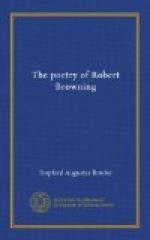But even without great knowledge such poems may be written, if the poet have imagination, and the power to execute in metrical words what has been imagined. Theology in the Island and the prologue to a Death in the Desert are examples of this. Browning knew nothing of that island in the undiscovered seas where Prosper dwelt, but he made all the scenery of it and all its animal life, and he re-created Caliban. He had never seen the cave in the desert where he placed John to die, nor the sweep of rocky hills and sand around it, nor the Bactrian waiting with the camels. Other poets, of course, have seen unknown lands and alien folks, but he has seen them more vividly, more briefly, more forcibly. His imagination was objective enough.
But it was as subjective as it was objective. He saw the soul of Fra Lippo Lippi and the soul of his time as vividly as he saw the streets of Florence at night, the watch, the laughing girls, and the palace of the Medici round the corner. It was a remarkable combination, and it is by this combination of the subjective and objective imagination that he draws into some dim approach to Shakespeare; and nowhere closer than in these poems.
Again, not only the main character of each of these poems, but all the figures introduced (sometimes only in a single line) to fill up the background, are sketched with as true and vigorous a pencil as the main figure; are never out of place or harmony with the whole, and are justly subordinated. The young men who stand round the Bishop’s bed when he orders his tomb, the watchmen in Fra Lippo Lippi, the group of St. John’s disciples, are as alive, and as much in tune with the whole, as the servants and tenants of Justice Shallow. Again, it is not only the lesser figures, but the scenery of these poems which is worth our study. That also is closely fitted to the main subject. The imagination paints it for that, and nothing else. It would not fit any other subject. For imagination, working at white heat, cannot do what is out of harmony; no more than a great musician can introduce a false chord. All goes together in these poems—scenery, characters, time, place and action.
Then, also, the extent of their range is remarkable. Their subjects begin with savage man making his god out of himself. They pass through Greek mythology to early Christian times; from Artemis and Pan to St. John dying in the desert. Then, still in the same period, while Paul was yet alive, he paints another aspect of the time in Cleon the rich artist, the friend of kings, who had reached the top of life, included all the arts in himself, yet dimly craved for more than earth could give. From these times the poems pass on to the early and late Renaissance, and from that to the struggle for freedom in Italy, and from that to modern life in Europe. This great range illustrates the penetration and the versatility of his genius. He could place us with ease and truth at Corinth, Athens or Rome, in Paris, Vienna or London; and wherever we go with him we are at home.




